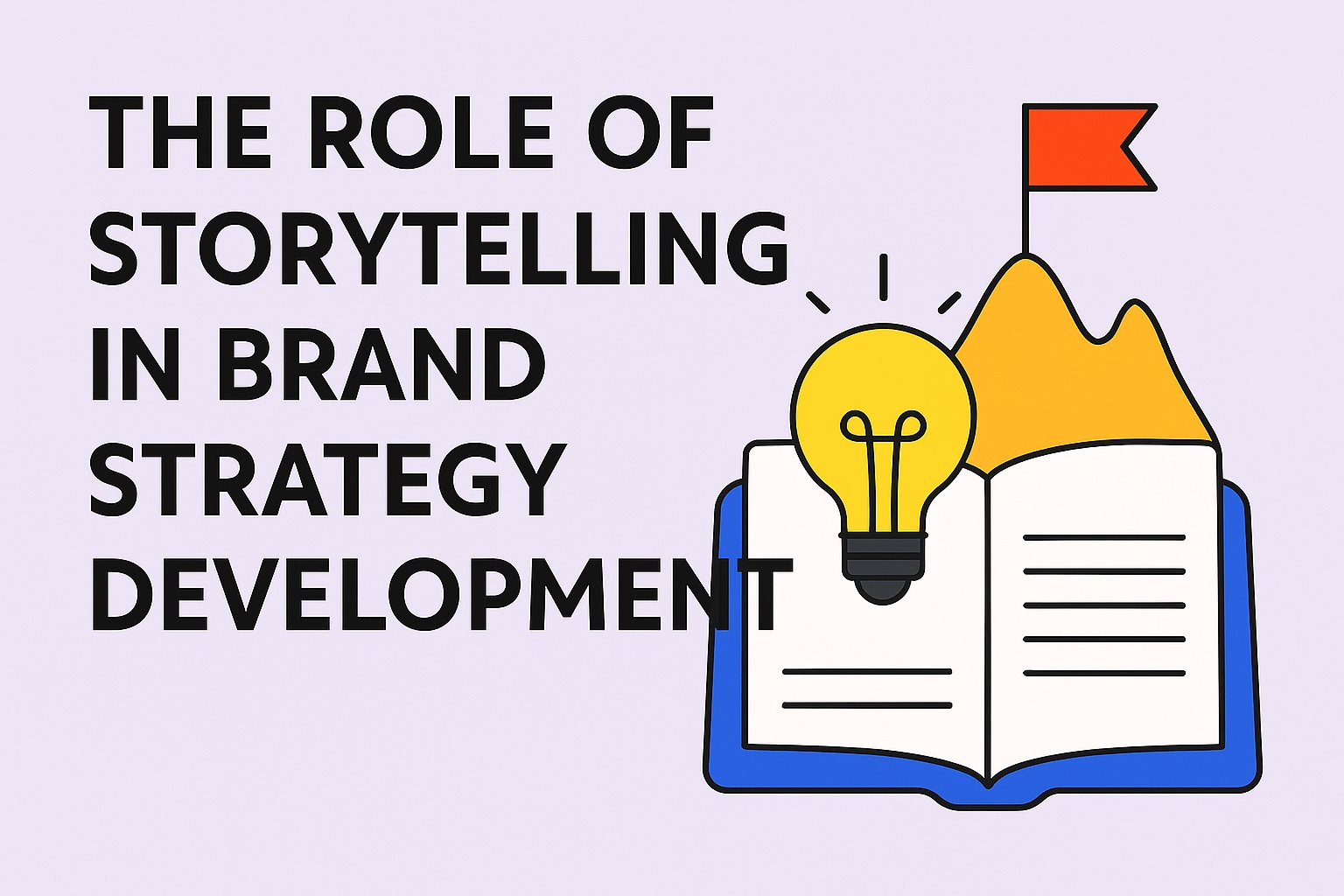Introduction:
In the world of brand strategy development, storytelling has emerged as one of the most powerful tools businesses can use to create an emotional connection with their audience. A compelling story can transform a brand from just another business into a memorable experience that resonates with customers on a deeper level.
Storytelling in brand strategy is not just about crafting an engaging narrative; it’s about communicating the values, mission, and vision of a brand in a way that speaks to the heart of the consumer. In this blog, we’ll explore how storytelling plays a crucial role in brand strategy development and why businesses should harness its power to build lasting relationships with their customers.
What is Storytelling in Brand Strategy?
Storytelling in brand strategy refers to the process of using narratives to convey a brand’s values, culture, mission, and identity. It’s about creating a story that connects with customers, inspiring them to relate to the brand on an emotional level. When executed correctly, storytelling can build trust, loyalty, and a sense of community around a brand.
In essence, brand story is how a company weaves its history, mission, and core values into a narrative that people can engage with. This goes beyond just the products or services the brand offers; it taps into the emotions and experiences of the audience. When customers feel connected to the brand’s story, they are more likely to become loyal advocates.
Why Storytelling Matters in Brand Strategy Development
1. Builds Emotional Connections
People remember stories, not facts or figures. When you tell a compelling story, it creates an emotional connection with your audience. In fact, research has shown that emotional connections drive higher customer loyalty and brand advocacy. By using storytelling in your brand strategy development, you humanize your brand and make it more relatable to your target audience.
For instance, consider Nike’s “Just Do It” campaign. The brand has built a narrative around overcoming personal challenges, persistence, and empowerment. This story resonates with millions of athletes and everyday individuals who relate to the idea of pushing beyond their limits. The emotional connection formed through this story makes Nike more than just a sportswear brand—it becomes a symbol of perseverance and determination.
2. Differentiates Your Brand
In today’s competitive market, standing out from the competition can be difficult, especially in industries where many brands offer similar products or services. Storytelling provides a unique opportunity to differentiate your brand by showcasing what makes you different beyond just the features of your products.
When a brand tells its unique story—whether it’s about how it started, its mission, or the impact it wants to make in the world—it helps create a distinct identity. For example, Patagonia has built a brand story around sustainability and environmental activism. This narrative not only sets Patagonia apart from other outdoor brands but also appeals to customers who share the company’s values.
3. Creates Brand Consistency
Storytelling is an essential tool for maintaining brand consistency across all channels. Consistent messaging is key to building a strong brand presence, and storytelling ensures that your brand’s voice remains the same, whether you’re engaging with customers on social media, your website, or in advertising campaigns.
When you have a clear and consistent story, it reinforces the core values and beliefs of your brand. This consistency helps customers quickly identify with your brand and creates trust. For example, Coca-Cola has consistently told the story of happiness, togetherness, and refreshment, from its iconic holiday campaigns to its everyday advertisements. This consistency in storytelling has allowed Coca-Cola to remain a globally recognized and trusted brand.
4. Engages Customers and Encourages Loyalty
One of the key reasons storytelling is so effective in brand strategy development is its ability to engage customers. A compelling narrative not only captures the audience’s attention but also keeps them coming back for more. When your customers feel like they are part of your brand’s story, they are more likely to develop a sense of loyalty and advocacy.
This is why brands like Apple have managed to create such loyal followings. Apple’s story focuses on innovation, simplicity, and creativity. These values resonate deeply with its customers, who not only purchase products but also become passionate advocates of the brand. The emotional connection that storytelling builds encourages repeat business and word-of-mouth marketing.
5. Humanizes Your Brand
People connect with people, not faceless companies. Storytelling allows you to humanize your brand by showcasing the people behind the business, the challenges you’ve faced, and the journey you’ve taken to get to where you are today. This human element makes your brand more relatable and approachable, which fosters trust and emotional engagement.
A great example of this is TOMS Shoes. The brand’s story revolves around its mission to help others by donating a pair of shoes for every pair purchased. This simple yet powerful story resonates with consumers who are looking to support brands with a purpose. By sharing this narrative, TOMS has not only sold shoes but has built a loyal customer base that shares its values of social responsibility and philanthropy.
How to Incorporate Storytelling into Your Brand Strategy Development
1. Define Your Brand’s Core Values
Before you can tell your brand’s story, you need to understand what it stands for. What are the core values that drive your business? These values should be at the heart of your story and guide how you communicate with your audience. Whether it’s sustainability, innovation, customer-centricity, or something else, your values should shape the narrative you tell.
2. Identify Your Brand’s Unique Story
Every brand has a unique story, whether it’s about how the business was founded, the challenges it’s overcome, or the mission it strives to accomplish. Look back at the history of your business and identify the key moments and milestones that have shaped your journey. Share the human side of your brand and what makes it different from competitors.
3. Know Your Audience
To create a story that resonates, you need to know your audience inside and out. What are their pain points, desires, and motivations? Tailor your brand’s story to speak directly to their emotions and needs. The more relatable your story is to your audience, the more likely they will engage with it.
4. Keep Your Story Consistent
Consistency is key in brand storytelling. Whether you’re telling your story through your website, social media, or advertisements, ensure that the tone, message, and core values remain consistent across all channels. This consistency reinforces your brand identity and makes your story more recognizable.
5. Make Your Story Authentic
Authenticity is critical in storytelling. Customers can tell when a brand’s story feels forced or inauthentic, which can lead to a loss of trust. Be honest about your challenges, successes, and the journey you’ve taken. Share real stories, and don’t be afraid to show vulnerability. Authenticity builds credibility and helps customers connect with your brand on a deeper level.
Examples of Successful Brand Storytelling
1. Nike
Nike’s “Just Do It” campaign is a prime example of brand storytelling. The brand’s story focuses on perseverance, determination, and pushing beyond personal limits. By sharing stories of athletes overcoming adversity, Nike has created a powerful emotional connection with its audience.
2. Airbnb
Airbnb’s story revolves around belonging and the idea of creating unique travel experiences. The brand tells stories of hosts and guests from around the world, showcasing the human connections that are made through the platform. This story has helped Airbnb build a loyal customer base that values authenticity and connection.
3. Dove
Dove’s “Real Beauty” campaign is another great example of brand storytelling. The campaign focuses on promoting self-esteem and challenging traditional beauty standards. By telling stories of real women and celebrating diversity, Dove has positioned itself as a brand that cares about women’s confidence and self-worth.
Conclusion:
Storytelling plays an integral role in brand strategy development. It humanizes your brand, builds emotional connections, differentiates you from competitors, and creates lasting customer loyalty. By crafting a compelling brand narrative, you can engage your audience, create trust, and inspire action.
If you’re looking to develop a strong brand strategy and use the power of storytelling to connect with your audience, Website Legends can help. Contact us today to learn how we can help you create a brand story that resonates and drives success.
FAQs:
- What is brand storytelling?
Brand storytelling is the use of narratives to communicate a brand’s values, mission, and identity. It focuses on engaging the audience emotionally and making the brand more relatable. - Why is storytelling important for brands?
Storytelling helps brands connect with their audience on a deeper emotional level, build trust, differentiate from competitors, and create long-lasting customer loyalty. - How do I create a brand story?
To create a brand story, define your brand’s core values, identify key moments in your journey, understand your audience, and keep your story consistent and authentic across all communication channels. - Can storytelling help my business stand out?
Yes, storytelling is an effective way to differentiate your brand from competitors. It creates a unique narrative that resonates with customers, making your business more memorable. - How can I incorporate storytelling into my brand’s marketing?
Incorporate storytelling into your marketing by weaving your brand’s narrative into your website content, social media posts, ads, and other marketing materials. Ensure consistency in tone and messaging across all platforms.


